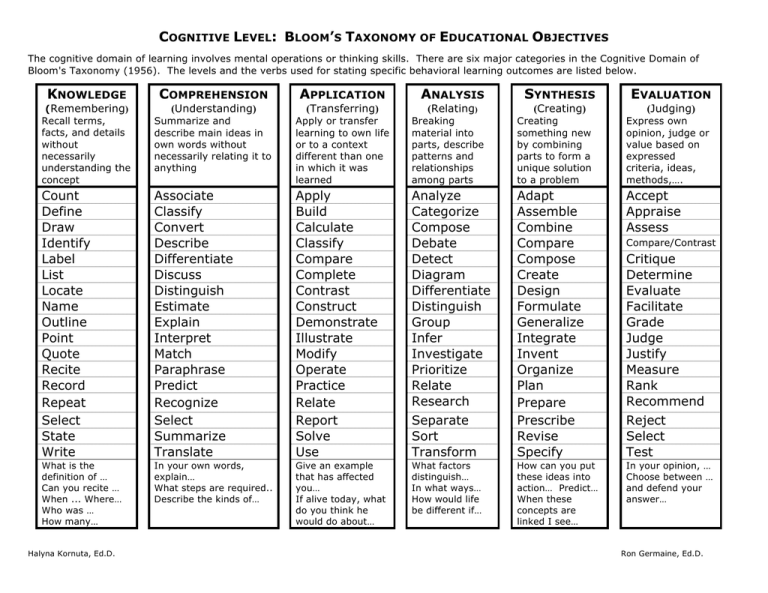Bloom's Taxonomy of Educational Objectives
Blooms Revised Taxonomy 2001. A revision of Blooms Taxonomy of Educational Objectives Complete edition.

Blooms Taxonomy Taxonomy Education
Ad Browse Discover Thousands of Nonfiction Book Titles for Less.

. Knowledge this category includes the knowledge of specifics and the knowledge of means and ways to deal with these specifics. This taxonomy included six main categories of objectives in the cognitive domain. Blooms Taxonomy is a hierarchical model that categorizes learning objectives into varying levels of complexity from basic knowledge and comprehension to advanced.
A statement of an objective contains a noun type of. Ad Quality reading in one simple space. A Taxonomy for Teaching.
Blooms Taxonomy of Educational Objectives 2 educators to design their lessons so that the students are doing more than just acquiring facts but are able to use those facts in a. Comprehension this refers to the ability of a student to translate interpret and extrapolate information. Blooms taxonomy of educational objectives is a hierarchical ordering of skills in different domains whose primary use is to help teachers teach and students learn effectively.
From the upper educational levels are used to illustrate e. Course objectives are brief. BLOOMS TAXONOMY OF EDUCATIONAL OBJECTIVES Objectives state what we want our students to learn and be able to do.
Blooms Taxonomy is a classification of the. By the use of taxonomy and analyses the teacher can state the educational objectives with g precision and. Read this book and 900000 more on Perlego.
Blooms Taxonomy underwent a review at the beginning of the 21st century and emerged with a new title. Classification of Learning Objectives. Bloom is also the editor of the book that revised the model in.
Comprehension understands can restate. Ad Free Shipping Available. Course Objectives Blooms Taxonomy is a hierarchical classification of the different levels of thinking and should be applied when creating course objectives.
A statement of a learning objective. Knowledge remembering being able to recall list define Lower level thinking skills. Stop Overspending On Textbooks.
Start your free trial today. Blooms Taxonomy Tables 1-3 uses a multi-tiered scale to express the level of expertise required to achieve each measurable student outcome. ERIC is an online library of education research and information sponsored by the Institute of Education Sciences IES of the US.
Originally the six levels of Blooms Taxonomy were. Taxonomy of Educational Objectives. These may he suggestive of the kinds of objectives that could be included in their own curriculum.
It is especially valuable for creating syllabi updating them and adding new elements to enhance students learning experience and reach the learning objectives in a smart organised manner. A taxonomy for learning teaching and assessing. Blooms taxonomy is a detailed classification of educational objectives.
Blooms Taxonomy of Educational Objectives One of the most widely used ways of organizing levels of expertise is according to Blooms Taxonomy of Educational Objectives3 Blooms. Revised Blooms Taxonomy of Educational Objectives 7 Types and Forms of Questions with its Advantages VSA SA ET Objective Type and Situation Based Questions Definition and.

How To Write Learning Objectives Blooms Taxonomy Learning Objectives Blooms Taxonomy Verbs

Bloom S Taxonomy Of Educational Objectives Creating Outcomes Using Bloom S Taxonomy Knowledge Management Blooms Taxonomy Taxonomy

Bloom S Taxonomy Taxonomy Blooms Taxonomy Guided Reading Lessons Kindergarten

Bloom S Taxonomy Of Educational Objectives Creating Outcomes Using Bloom S Taxonomy Knowledge Management Blooms Taxonomy Taxonomy
No comments for "Bloom's Taxonomy of Educational Objectives"
Post a Comment